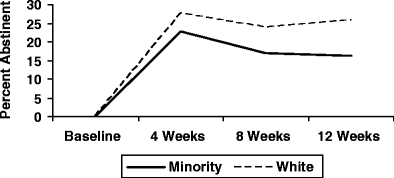Racial differences in smoking abstinence rates in a multicenter, randomized, open-label trial in the United States
- PMID: 21088690
- PMCID: PMC2967232
- DOI: 10.1007/s10389-009-0277-2
Racial differences in smoking abstinence rates in a multicenter, randomized, open-label trial in the United States
Abstract
BACKGROUND: This study evaluates differences in smoking abstinence between white and minority smokers using pharmaceutical aids. METHODS: This is an analysis of data from a multi-center, randomized, clinical trial conducted in the United States. Of the 1,684 subjects randomized to one of three medications (nicotine inhaler, bupropion, or a combination of both), 60% were women and 10% were minority races. RESULTS: Factors associated with a decreased likelihood of smoking at 12 weeks were older age (OR = 0.971, p < 0.0001), being married (OR = 0.678, p = 0.0029), using bupropion SR (OR = 0.480, p < 0.0001), and using combination therapy (OR = 0.328, p < 0.0001). Factors associated with an increased likelihood of smoking were higher tobacco dependence scores (OR = 1.244, p < 0.0001), prior quit attempts (OR = 1.812, p = 0.004), and being a minority (OR = 1.849, p = 0.0083). Compared to white smokers, minority smokers were significantly older at time of study entry (46 vs. 42 years, p < 0.0001), less likely to be married (35% vs. 59%, p < 0.0001), older at smoking initiation (21 vs. 19 years of age, p < 0.0001), and had a lower abstinence rate (16% vs. 26%, p = 0.0065). CONCLUSION: Regardless of the treatment used, minority smokers in the US have lower smoking abstinence after treatment for tobacco dependence. Future research should focus on the improvement in treatment strategies for minority smokers.
Conflict of interest statement
The authors confirm that there are no relevant associations that might pose a conflict of interest.
Figures
References
-
- American Lung Association (2006) Trends in tobacco use. http://www.lungusa.org/site/c.dvLUK9O0E/b.33347/k.AC09/Data__Statistics.htm
-
- Center for Disease Control and Prevention Smoking cessation during previous year among adults—United States 1990 and 1991. MMWR. 1993;42:504–507. - PubMed
-
- Center for Disease Control and Prevention Tobacco use among adults—United States 2005. MMWR. 2006;55(42):1145–1148. - PubMed
-
- Centers for Disease Control and Prevention Cigarette smoking among adults—United States 2007. MMWR. 2008;57(45):1221–1226. - PubMed
Grants and funding
- U10 CA052352/CA/NCI NIH HHS/United States
- N01 CA035431/CA/NCI NIH HHS/United States
- K05 CA124477/CA/NCI NIH HHS/United States
- U10 CA037404/CA/NCI NIH HHS/United States
- U10 CA035448/CA/NCI NIH HHS/United States
- U10 CA035101/CA/NCI NIH HHS/United States
- U10 CA035431/CA/NCI NIH HHS/United States
- U10 CA025224/CA/NCI NIH HHS/United States
- U10 CA063848/CA/NCI NIH HHS/United States
- U10 CA035195/CA/NCI NIH HHS/United States
- U10 CA035113/CA/NCI NIH HHS/United States
- P30 CA015083/CA/NCI NIH HHS/United States
- N01 CA015083/CA/NCI NIH HHS/United States
- U10 CA035103/CA/NCI NIH HHS/United States
LinkOut - more resources
Full Text Sources
Research Materials

